Kashmir: A Journey To Paradise And Back!
By Gagan Rism
08 June, 2010
Countercurrents.org
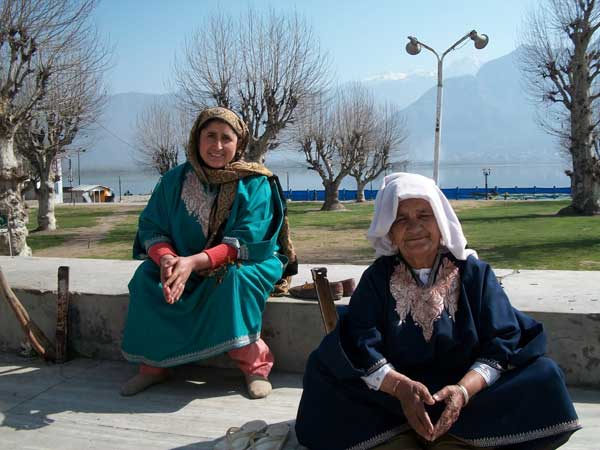
Two kashmir women outside hazrat bal
“There is absolutely nothing to worry about, it’s perfectly safe over there…” one of my acquaintances Mr. Jai Krishan Raina assured me over the phone, “Just go and enjoy. I will keep in touch with you at all times as well as my friends there.” Assured thus by my acquaintance, I finally reached Srinagar on 13 March, 2010 to attend a National Conference on Web Resources organized by Dept of Library Science in University of Kashmir. His friends, Mr. Sajjad, Inspector in Jammu Police Head Quarters and his brother Zahid had kept noting the details of my 8-hour long journey by car from Jammu to Srinagar since no direct train service are available to Srinagar from Mumbai. I was told by my host Mr. Shingloo at Jammu that the routine plying of cars on this route. The joy-ride had been curiously surprising as nothing of my imaginations spurred by bollywood romances could be seen. The bare, rocky terrain! No snow, no Chinars, nothing. I waited for the snowy peaks to turn up any moment, but there came none. Is this what they called Kashmir? I wanted to believe that the Kashmir we had seen in bollywood romances was not that bare cliffs. However, the route was busy as I was told. Plenty of Sumos, Taveras, Safaris and Marutis I saw plying – riding passengers from Jammu to Srinagar. The occasional skinny falls flowing down from the bosom of bare-cliffs, bridges, people clad in firans, fleets of CRPF buses coming from Srinagar carrying half-sleeping soldiers, small temples, and yes - the dhabas! The best sight among all of these!
I could never have imagine that I would see something like dhabas in Kashmir which is so northern, so peculiarly… ours! But guess! I saw a whole range of dhabas - vaishno, shudh-shakahari, veg-non veg, and even Punjabi Dhabas arrayed along the way! That boosted my self-confidence. No amount of factual statements by people back home and at IIT Bombay hostel had been successful so far to home in on me the fact that I was going to a militancy-prone area and ideally, I should, be worried! Their pleasant signboards instilled the feeling that I was not treading some foreign land, but my very own country. If anything that connects India together, whether rural or urban, conflict-zones or peaceful, is the presence of these dhabas on its roads. Their sight on the road leading me to a place called Kashmir – the supposedly militancy-infested region for ages, was so pleasant, so reassuring that nothing that is reported in papers, news-channels, internet mattered at all! If dhabas, the face of traveling India can survive, we too will! One must not miss, at this juncture, the famed rajma - chawal of Peeda - a wholesome bowl of rice dabbled with small-sized rajmas with good amount of desi ghee sprawled over it! That’s worth all the fame it has! The spell of dhabas got taken over by the famed Jawahar Tunnel after six hours - 3 km long tunnel built by carving the entire mountain from the middle connecting valley of Srinagar with Jammu and takes around twenty minutes to cross it. Across that tunnel, starts the Valley. The moment we came out, it appeared as if we had stepped into something unearthly. All of a sudden, vast expanse of green steppe greeted our view, surrounded by snow-capped mountains yonder. One of the sign-board welcomed us with, “First View of the Valley.” As our car rolled down the road, the beauty of valley unfolded with views of chinars, rural villages, and the snow-peaked mounts beyond. Each one appeared one by one with coquettishness of a doyenne, as if. Kashmir is like that only. As a flower unfurls itself, petal by petal, so does the beauty of Kashmir - it presents itself to the viewer, layer by layer.
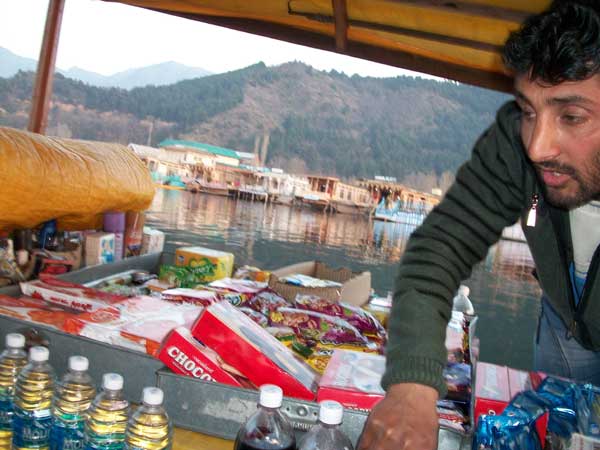
A confectionary-selling shikara on dal
By 4.20, I reached Lal Chowk, the busy marked of Srinagar, got picked by my host Mr. Zahid and was dropped at University Guest House. For the next three days, I kept busy with the conference, but evenings used to be all mine! While wondering about the surprisingly domineering hoardings of telecom giants Reliance, Tata, Vodafone overhanging the roofs of the shops, our teenage auto-driver Rashid on way to Nishat Bagh told, “It’s all Postpaid that is allowed here,” and rued rather hesitatingly, “Why can’t they allow us prepaid? It is allowed in entire India, no?” We, me and a professor from TISS, Satish Kanmadi, did not have any answer. And then, we were made speechless further by the sites. Hazratbal, Nishat Bagh, Badamvari wondering all along at the might of the Mughal empire! What a place they chose to realize their architectural dreams – 5200 feet above sea level! Badamvari, the big garden of almond trees, snuggled quietly at the foothills of Akbar Fort perched on top of the mountain adjacent to it! “But this is close for tourists for last some ten years,” the host, Prof. Nadeem, accompanying me told, “At present, CRPF has its posts there. It gives them a wholesome view of the valley!” The full-bloomed garden with white flowers seemed to cast a mockery at the iron above. Mughal Garden, with snow-capped mountains overlooking it so closely that makes you tempted to lift your hand and just touch its snowy forehead! The legendary couplet comes to mind instantly. It was here that Mughal Emperor Jahangir had said, ‘If there is heaven on earth, then here it is, here it is, here it is…’ The emperor was right for once in his life, at least! (Historians excuse!) Like gardens, Dal Lake, too, did not have many tourists at that time. Hardly, a few. “Come the season, and you will find plenty of them. Indian, foreign,” our shikarawala, Gulzar, a lanky youth of around 23 years of age, told us. He showed us the method of rowing a shikara and how it is owned by everybody there, “just like cycles are owned in your city by everyone, here every family owns a shikara.” While telling us about the buildings on surrounding hills, and hotels, he gestured, “that is Pari Mahal.. and that is the house of our CM.” I asked jokingly if their CM too knew how to row a shikara, he sneered, “Why does he need to? He goes by aeroplane.” With the mention, the conversation turned to politics. The duo fumed at the Central Government’s prejudice against Kashmiris, as expected. However, what was not expected was their regret with the local government which was rather more. “What the [state] government has done so far for the people? Nothing, absolutely nothing. They just know how to fill their pockets.” I shared my knowledge of Sher Abdulla to which Mehraj, the other rower, remarked, “Yea, he was a great man! But that is a thing of past long ago! Here is now his grand-son. What he has done? Nothing but building a few roads so far! But people need education, jobs.. You can see when there is no season, it becomes hard to make both ends meet for us.” I discerned it to be true.
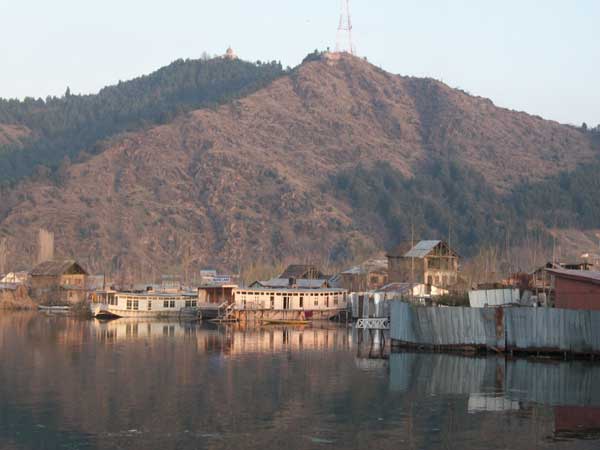
Dal lake with houseboats
All the houseboats around were practically empty, shikaras lined up by the bank waiting for occasional tourists. I asked him if there could be better alternative for the government at the helm, to which he replied indifferently, “All are like that. Just know how to exploit people. Do you see how dirty the lake has become?” That part from where our shikara was being rowed was littered with all kinds of stuff. He went on, “The government had imported machines worth rupees 60 crores from foreign for cleaning up the lake. And only 12 crores have been spent so far! Rest, no one knows where did it go? What is the use of choosing other man? When other candidate will come, he too will do the same thing. I hate politics, I tell you.” That ended our 3 hour long discussion.
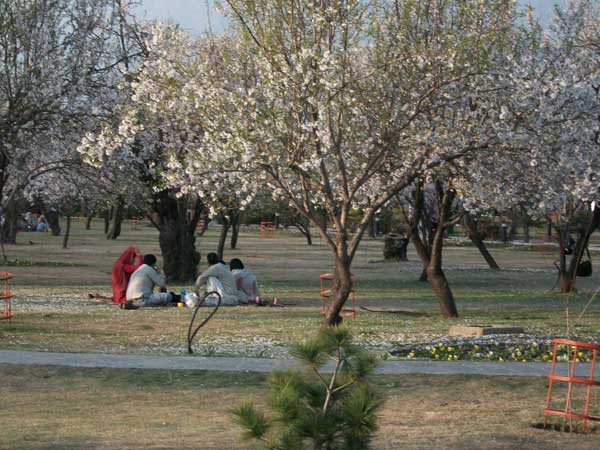
A local family enjoying picnic in badamvari
The most amazing thing however was that not once did the two guys mentioned militancy. When I asked if that was a problem too, they brushed it aside saying, “That was years ago. Now, there has been no major militant activity for the last 6-7 years. Small shoot-outs occur, but don’t they happen in other parts of the country? Business is booming for the last few years, but the problems we face are largely due to lack of basic facilities! There is little education, little business opportunities and practically no jobs! What should we do?” I realized the difference between Kashmir we see in media and Kashmir that is in reality - living, fighting with poverty, with government, with day to day needs, and not just militancy! The youth is struggling, disgruntled, and disappointed. His choosing not to vote and be not a part of this dirty business seems a natural way of giving vent to his disappointments. The representation that is done on their behalf in the parliament, they refuse to identify with it. Prof. Sumeer Gul, the Conference organizer, remarked in this context, “What kind of representation is that? I tell you the fact. I was the polling officer at Barkhana polling booth in last election. Out of 4500, only 60 people turned up for voting. People simply don’t vote, and those who do, often for money in return. They don’t have enough to survive, you see.” That was something what the shikarawala Gulzar trying to say, and a lot many others, on different occasions. I could see the frustration of semi-educated lot giving returns this way. However, the most resounding endorsement of that came from one of the local participants in the seminar, a highly educated youth, was to retort right there in the session, “I don’t vote, and I never will.”
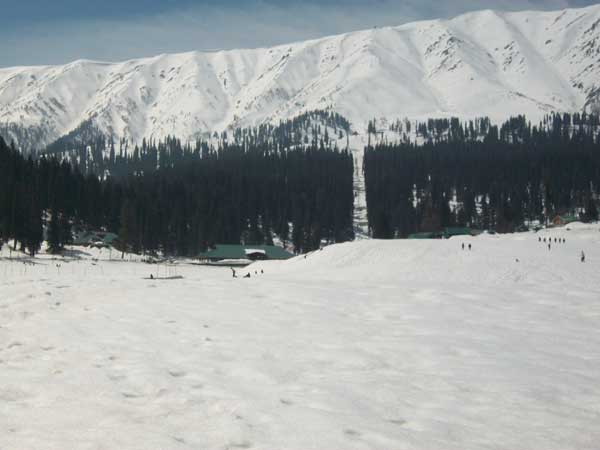
Gulmarg with way of gondola carriers showing in middle
However, things brightened up with trip to Gulmarg which seems just like a bowl of kheer (sweet rice pudding) snuggled in the lap of Himalayas. In the mid-March, 7-8 feet snow is a feast for the tourist, when most of the snow has already melted. “It will be all gone by April end,” our guide told us – the team of three. He showed the adjoining hills where, “shrines of all the religions are there. Temple, Gurudwara, each on its respective hill.” Having hired sledges for 700 per head, we reached the base of the overlooking mountain and boarded the Gondola – the world’s highest cable-car ferrying tourists from Gulmarg base to Seven Springs above, at the feet of 10,000 feet, charging 300/- per head. From there, another Gondola carries people to Kongdori Mountain, at height of 13,500 feet with extra charge of 500/-. “Across that mountain is LoC, you can see that from telescopes installed there,” told our guide. Though, being near LoC was exciting, however, we dropped the idea of another ride because of time crunch, took a quick snack at the restaurant at 10,000 feet itself, and headed back. One may try Punjabi and Khalsa restaurants at Gulmarg base. Only thing that pinched while walk down the vast snowfield, however, was the trash littered here and there - empty water bottles, polythene sachet-packs, and so on. Our guide was a middle aged cheerful fellow who got talking to me. A bit later, he asked me earnestly if I had really enjoyed being in Kashmir. Of course, I was having enjoyment of lifetime, and Gulmarg was literal paradise, I told him animatedly, “Only this junk, I did not like.
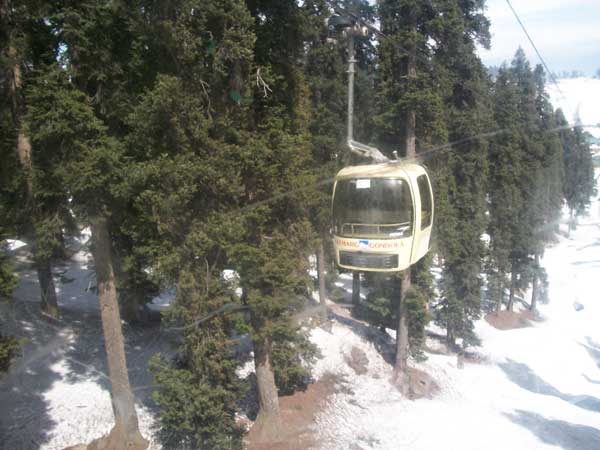
A gondola passing by
This is such a vast snowfield, but not many dust-bins around can be seen.” Tottering clumsily by his side on thick snow, I said, “There should be more dust-bins put here and there. This junk defaces....” He interjected, muttering, “The tourist himself should also have some civic sense, no?” I gaped with wonder, while he continued, “I tell you one thing, all this litter is the work of Indian tourists. These foreign tourists never throw junk anywhere. They would carry even the wrapper of a toffee to mile, but throw only in dust-bin. But, Indian tourists…. they don’t bother.” I asked if he insists those Indian tourists to kindly throw the junk in dustbins only. He smiled, and said, “How can I say so? Tourist is like God, whatever he says, we have to admit.” With that, he turned serious and said, “Look beta, the tourist here comes not like other cities. They might act decent in other places, but here, they don’t really care. If we would say anything, why, the tourist will say, go to hell, we don’t come here at all, then what? Already, the tourism has so badly affected. It will take years to stand it on its feet…” I realized the condition to be between well and the pit. I wondered what the management of that place was doing. He sighed, “Nothing. This government is of no use!” and went on to detailing practically everything what shikarawalas had told me earlier. I asked him the same question of choosing alternative, and I was taken aback by the same answer, “Everybody would be like them only. That’s why, I don’t vote.” His grievance, too, was more with the state government than the central; he too had the same solution of keeping out – by not voting! It was there, ironically, that I realized the need of voting! Something that had kept popping on one or the other way throughout my stay! Whether it is the illiterate rural folk that Prof. Sumeer talked about, or semi-literate shikarawalas or highly educated that political science fellow – the solution of keeping out of system by not voting, seemed pathetically farcical to me. Pathetic, because such means of reaction, the system has
reduced us to! Powerless, frustrated, annoyed, we think by not choosing will keep us from suffering if we did choose and that turned out to be bad. But it is farcical, because if we won’t choose our representatives, then somebody else is going to choose on our behalf. And when that choice is done, we won’t have any right to complain the bad choice, since by not allowing good choice, we allowed bad representative to come. Anticipating ‘like that only’ to be the result is not going to buttress our escapism. It’s not magic; you wield the wand, and system changes overnight. It is democracy, and things change by and by here. But, for that, everybody has to work.
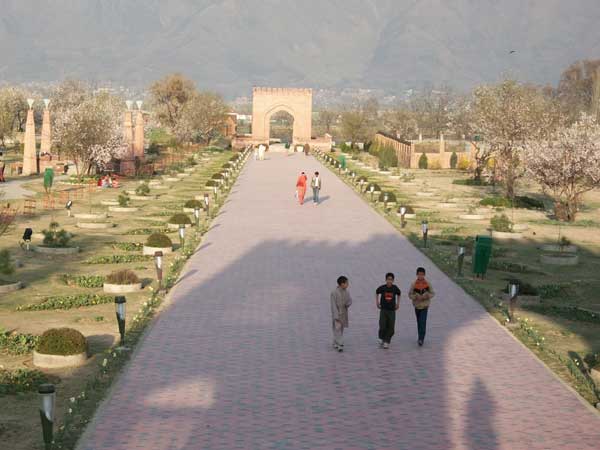
Badamvari
Apart from ethereal beauty, Kashmir had lot many lessons to give, esp. in image-difference. What Kashmir is portrayed in media, and what it in reality is, are so different. Kashmir is not about militancy alone as media portrays it to be; it is about people, like you and me – their hopes, needs and aspirations, their daily struggle to keep alive with dignity and of course, it is about beautiful landscape, soft music of those old romances. True, rest-of-India perception, at times, fails in Kashmir. I particularly remember that hilarious incident when we, the 3 participants, stood nearby army vehicles to be better spotted by our host Mr. Zahid in the otherwise closed market. Prof. Nadeem, who happened to go by coincidently, was to reprimand us later, “Why were you standing near those army vehicles? My god, you were the ‘soft targets’. Just in the morning, they have thrown grenades upon army, and two army people died….” It was then, amid laughter, we learned – never stay near army people in Kashmir! This is how,
sometimes, rest-of-India and Kashmir perception of reality go different ways! Apart from that hilarious escape, I did not find anything of the militating sort during my entire stay. That was my only brush with media-famed Kashmir militancy there. But, can’t that happen in any other part of the country? I believe that if I, a girl, can go journeying alone 8 hours in that lonesome, hilly stretch from Jammu to Srinagar, stroll carelessly in the busy market taking pictures without any threat, I don’t see any reason why others can’t. What more security people might be looking for? If that is not enough, may be the fleets of CRPF buses that I saw on the way leaving Srinagargive some clue!
Gagan Rism is a research scholar studying in IIT Bombay, India. For the last 11 years she is writing fiction - short stories and poetry which have been published in various journals/anthologies of India. Email- [email protected]
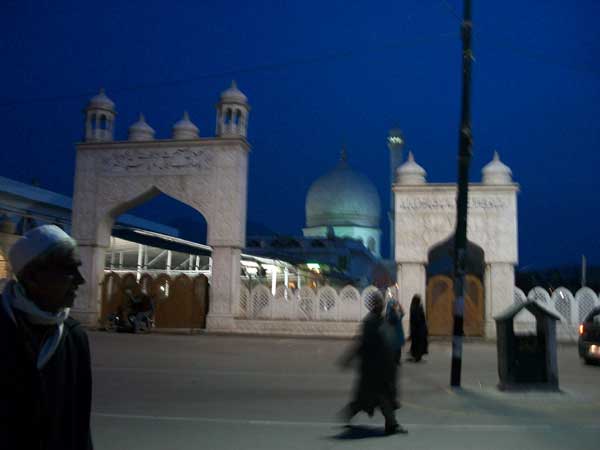
Hazratbal in evening

